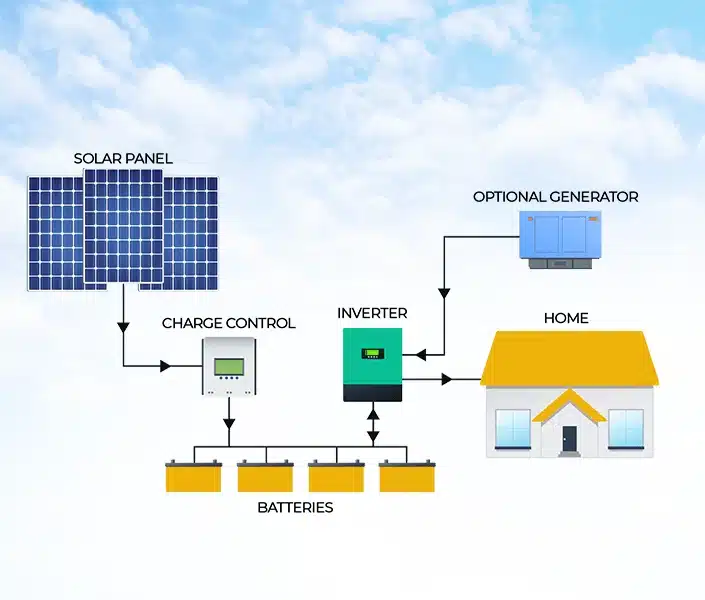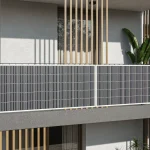In today’s era, solar energy has become a trend, with more and more people opting to try solar power. For those just starting to explore solar energy, a common question might arise: What if I build a completely off-grid solar power system? Is it cost-effective? This doubt is entirely normal, after all, who can resist the temptation of not paying electricity bills? However, I must point out that establishing a complete off-grid solar system requires careful consideration and is not always the most cost-effective option.
Calculating Electricity Bills
To determine whether an off-grid solar system is cost-effective, we first need to understand our current electricity expenses. Let’s assume an example to demonstrate this calculation. Suppose we live in California, a sunny place that is very suitable for installing solar energy. We live in a house, not an apartment. Generally speaking, a house’s monthly electricity consumption is between 800-1000 kWh. Here, we’ll use 800 kWh as our example. The average electricity rate in California is 31 cents per kWh. For simplicity, let’s calculate it at 30 cents per kWh. Therefore, our monthly electricity bill is approximately $240.
Monthly Electricity Calculation
- Monthly electricity consumption: 800 kWh
- Average electricity rate: $0.30 per kWh
- Monthly electricity bill: 800 kWh * $0.30/kWh = $240
Calculating the Cost of an Off-Grid Solar Power System
Now, let’s consider the cost of an off-grid solar power system. An off-grid solar power system usually consists of solar panels, controllers, batteries, and inverters. Cables and installation brackets are essential as well. For this analysis, we will focus primarily on the solar panels, which are the most significant component.

Daily Electricity Consumption
Based on our previous assumption, the monthly electricity consumption is 800 kWh. Therefore, the daily electricity consumption is:
- Daily electricity consumption: 800 kWh / 30 days ≈ 26.67 kWh/day
Not all of the day is sunny, but the solar panels still work and generate power even without direct sunlight. To be conservative, let’s calculate the peak sunshine hours as 8 hours per day. Assuming an efficiency rate of 90%, the electricity the solar panels need to produce daily is:
- Required daily electricity production: 26.67 kWh / 0.9 ≈ 29.63 kWh
Required Solar Panel Capacity
To find out the total power required for the solar panels, we divide the required daily electricity production by the number of peak sunshine hours:
- Required solar panel capacity: 29.63 kWh / 8 hours ≈ 3.7 kW
Cost of a 3.7 kW Solar Panel System
How much does a 3.7 kW solar panel system cost? In California, the price of solar panels is about $2.46 to $2.68 per watt. Let’s calculate it at $2.5 per watt:
- Cost of solar panels: 3.7 kW * $2.5/watt * 1000 watts/kW = $9,250
Note that this price includes installation costs. If you are handy and industrious, the cost might be lower. Adding the cost of controllers, inverters, batteries, etc., let’s round it up to $10,000. Thus, the payback period is:
- Payback period: $10,000 / $240 per month ≈ 42 months ≈ 4 years
Real-World Considerations
The calculation above might sound good, but several factors can affect these numbers. All the conditions in our calculation are very lenient. Here are some real-world considerations:
- Higher Household Electricity Consumption: Your household electricity consumption might be higher than 800 kWh per month.
- Peak Sunshine Hours: The actual peak sunshine hours might be less than 8 hours per day. In many regions, 6.5 hours is already plenty.
- Efficiency Rates: The efficiency rate of 90% is optimistic. Typically, it is around 80%.
In reality, the cost of installing a 5 kW system in California is about $12,000, with a payback period of around 5 years. Moreover, this is in California, where sunshine is abundant, and electricity rates are high, making the return on solar investment very high. If you live in a place with less sunshine and cheaper electricity, then installing an off-grid system is not the best choice. After all, the price of photovoltaic equipment doesn’t vary much from place to place, but the output does fluctuate significantly.
Other Factors to Consider
Government Incentives
Before making a decision, it’s essential to understand whether there are any government incentives available. Federal, state, and local incentives can significantly reduce the initial investment cost. For instance, the Federal Solar Investment Tax Credit (ITC) offers a 26% tax credit for solar systems installed through 2022, decreasing thereafter. Some states and municipalities offer additional rebates and incentives that can further reduce costs.
Battery Storage Costs
An off-grid solar system requires batteries to store excess power generated during the day for use at night or during cloudy days. The cost of batteries can be substantial and varies depending on the capacity and type (e.g., lithium-ion, lead-acid). Battery life and replacement costs should also be factored into the overall cost analysis.
Maintenance and Repairs
Solar panels and other system components require periodic maintenance and occasional repairs. While solar panels are generally low-maintenance, inverters and batteries have shorter lifespans and may need replacement during the system’s life. These costs should be included in the long-term financial plan.
Conclusion
In conclusion, installing an off-grid solar system is something that requires careful consideration. The upfront investment is over $10,000, and it takes several years to recoup the costs. Therefore, it is essential to understand whether the local sunshine intensity is suitable, whether the electricity rates support it, and whether there are corresponding government incentives. Of course, if you are quite wealthy and do not care about returns but want to contribute to green energy, then go ahead and do it!
Building an off-grid solar system can be a rewarding investment, both financially and environmentally, but it requires careful planning and realistic expectations. By considering all the factors discussed, you can make an informed decision about whether an off-grid solar system is the right choice for you.







